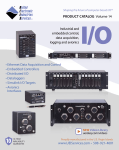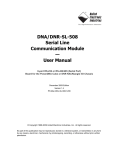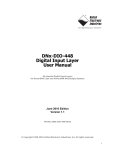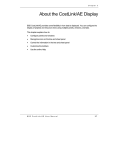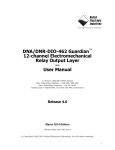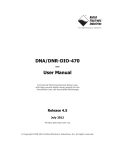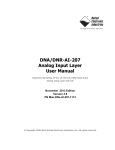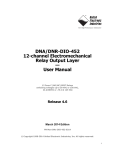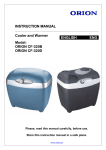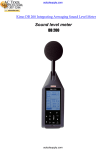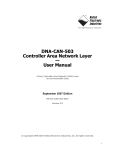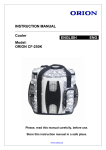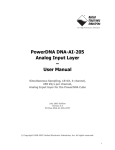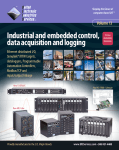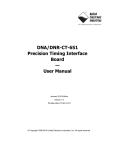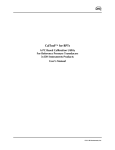Download DNA-STP-SYNC-1G Synchronization and Screw Terminal Panel
Transcript
DNA-STP-SYNC-1G Synchronization and Screw Terminal Panel — User Manual Accessory Panel for PowerDNA Cube (DNA) Systems and RACKtangle (DNR) Systems Version 1.2 July 2009 Edition PN Man-DNA-STP-SYNC-1G-0709 © Copyright 1998-2009 United Electronic Industries, Inc. All rights reserved. No part of this publication may be reproduced, stored in a retrieval system, or transmitted, in any form by any means, electronic, mechanical, by photocopying, recording, or otherwise without prior written permission. Information furnished in this manual is believed to be accurate and reliable. However, no responsibility is assumed for its use, or for any infringements of patents or other rights of third parties that may result from its use. All product names listed are trademarks or trade names of their respective companies. See UEI’s website for complete terms and conditions of sale: http://www.ueidaq.com/company/terms.aspx Contacting United Electronic Industries Mailing Address: 27 Renmar Avenue Walpole, MA 02081 U.S.A. For a list of our distributors and partners in the US and around the world, please see http://www.ueidaq.com/partners/ Support: Telephone:(508) 921-4600 Fax:(508) 668-2350 Also see the FAQs and online “Live Help” feature on our web site. Internet Support: [email protected] Web-Sitewww.ueidaq.com FTP Siteftp://ftp.ueidaq.com Product Disclaimer: WARNING! DO NOT USE PRODUCTS SOLD BY UNITED ELECTRONIC INDUSTRIES, INC. AS CRITICAL COMPONENTS IN LIFE SUPPORT DEVICES OR SYSTEMS. Products sold by United Electronic Industries, Inc. are not authorized for use as critical components in life support devices or systems. A critical component is any component of a life support device or system whose failure to perform can be reasonably expected to cause the failure of the life support device or system, or to affect its safety or effectiveness. Any attempt to purchase any United Electronic Industries, Inc. product for that purpose is null and void and United Electronic Industries Inc. accepts no liability whatsoever in contract, tort, or otherwise whether or not resulting from our or our employees' negligence or failure to detect an improper purchase. Table of Contents Chapter 1 The DNA-STP-SYNC-1G Panel ..................................... 1 1.1 DNA-STP-SYNC-1G Panel. . . . . . . . . . . . . . . . . . . . . . . . . . . . . . . . . . . . . . . . . . . . . 1 1.2 Description . . . . . . . . . . . . . . . . . . . . . . . . . . . . . . . . . . . . . . . . . . . . . . . . . . . . . . . . . 3 1.3 1.3.1 1.3.2 Synchronizing Multiple Cubes. . . . . . . . . . . . . . . . . . . . . . . . . . . . . . . . . . . . . . . . . . . 3 Synchronizing a 2-Cube System . . . . . . . . . . . . . . . . . . . . . . . . . . . . . . . . . . . 3 Synchronizing Multiple Cubes with DNA-STP-SYNC-1G Panels . . . . . . . . . . 4 A.1 Accessories. . . . . . . . . . . . . . . . . . . . . . . . . . . . . . . . . . . . . . . . . . . . . . . . . . . . . . . . . 7 B.1 Overview . . . . . . . . . . . . . . . . . . . . . . . . . . . . . . . . . . . . . . . . . . . . . . . . . . . . . . . . . . . 8 B.2 External Sync/Trigger interface . . . . . . . . . . . . . . . . . . . . . . . . . . . . . . . . . . . . . . . . . 9 B.3 B.3.1 Internal Sync Connections . . . . . . . . . . . . . . . . . . . . . . . . . . . . . . . . . . . . . . . . . . . . 10 Layer Triggering and Clocking . . . . . . . . . . . . . . . . . . . . . . . . . . . . . . . . . . . . 11 B.4 Use Application Cases . . . . . . . . . . . . . . . . . . . . . . . . . . . . . . . . . . . . . . . . . . . . . . . 11 Index . . . . . . . . . . . . . . . . . . . . . . . . . . . . . . . . . . . . . . . . . . . . . . . . . . . . . . . . . . . . . . . . . . 13 List of Figures Chapter 1 The DNA-STP-SYNC-1G Panel . . . . . . . . . . . . . . . . . . . . . . . . . . . . . . . . . . . . . 1 1-1 Photo of DNA-STP-SYNC-1G Panel ............................................................................. 2 1-2 DNA-STP-SYNC-1G Screw Terminal Panel.................................................................. 3 1-3 Interconnection Diagram for 2-Cube Synchronization ................................................... 4 1-4 DNA-STP-SYNC-1G Block Diagram.............................................................................. 5 1-5 Interconnection Diagram for Multi-Cube System .......................................................... 6 Appendix B . . . . . . . . . . . . . . . . . . . . . . . . . . . . . . . . . . . . . . . . . . . . . . . . . . . . . . . . . . . . . . . 9 B-1 Sync Interface Bus Diagram .......................................................................................... 8 B-2 Schematic of Internal Sync Connections ..................................................................... 10 DNA-STP-SYNC-1G Synchronization Panel Chapter 1 The DNA-STP-SYNC-1G Panel Chapter 1 1.1 DNA-STPSYNC-1G Panel The DNA-STP-SYNC-1G Panel The DNA-STP-SYNC-1G accessory panel facilitates the interconnection of multiple IOMs (PowerDNA Cubes, PowerDNR RACKtangle and HalfRACK units, or a mixture of both) for the purpose of synchronizing operations. Some of the characteristics of the unit are: Features • Compatible with all UEI IOMs — PPCx and GigE Cubes, RACKtangles, HalfRACKs, in any combination • Easy connections with standard accessory cables • Provides BNC, RJ-50 (10-conductor), and screw terminal connections on a single board • Easy DIN-rail mounting • CLK_IN, CLK_OUT, TR_IN, and TR_OUT Master Cube/IOM connections via BNC, RJ-50, or screw terminal • Buffers internal or external CLK and Trigger signals to up to 6 slaved chassis • Allows a master Cube to channel its trigger and clock pulses through buffers so that its timing matches that of its slaves • Drives triggers/clocks up to 25 feet • Daisy-chains to additional boards with standard BNC cables Table 1-1 Technical Specifications © Copyright 2009 United Electronic Industries, Inc. Clock/Trigger connections 3 types available: Screw Terminal, BNC, or from a Master Cube via DNA-CBL-SYNC-RJ-1G cable Slave Cube outputs 6 (DNA-CBL-SYNC-RJ-1G cable-compatible) Buffering All outputs fully buffered Intercube distance 25 feet max Size/Weight 4.25” by 4.0” /less than 8 oz. Operating Temp. (tested) -40°C to +85°C Operating Humidity 0 - 95% non-condensing Power Required +5 VDC (automatically provided by master or slaved cubes) Tel: 508-921-4600 Date: July 2009 www.ueidaq.com Vers: 1.2 File: DNA-STP-SYNC-1G_Chap1.fm 1 DNA-STP-SYNC-1G Synchronization Panel Chapter 1 The DNA-STP-SYNC-1G Panel Figure 1-1. Photo of DNA-STP-SYNC-1G Panel © Copyright 2009 United Electronic Industries, Inc. Tel: 508-921-4600 Date: July 2009 www.ueidaq.com Vers: 1.2 File: DNA-STP-SYNC-1G_Chap1.fm 2 DNA-STP-SYNC-1G Synchronization Panel Chapter 1 The DNA-STP-SYNC-1G Panel Slave 5 Slave 6 Master RJ-50 Screw Terminals Slave 4 Slave 3 RJ-50 Connectors Slave 2 Slave 1 BNC Connectors Figure 1-2. DNA-STP-SYNC-1G Screw Terminal Panel 1.2 Description 1.3 Synchronizing This section describes typical methods used to synchronize clocks of multiple Cubes and chassis. Multiple Cubes 1.3.1 The DNA-STP-SYNC-1G Sync Interface Interconnection Panel provides a simple means of connecting and synchronizing multiple UEI Cubes. A single Master Cube or an external signal source can be used as a Master for up to 6 systems. Groups of up to six Cubes can be slaved together by daisychaining STP-SYNC-1G panels with standard BNC cables. Connectors for UEI Sync cables, inputs, and outputs are provided on screw terminals and BNC connectors, which simplifies synchronization to an external device. Synchronizing Synchronizing a 2-Cube system is easily accomplished by simply connecting a cable between the Sync connectors on the two Cubes as shown in Figure 1-3. a 2-Cube One Cube is designated as Master and the other as a Slave. The connecting System cable, called DNA-CBL-SYNC-10, is a 30-inch 8-conductor cable with Sync connectors on both ends. For greater distances, use two DNA_CBL-SYNC-RJ1G cables plus an Ethernet crossover extender cable, as shown below. © Copyright 2009 United Electronic Industries, Inc. Tel: 508-921-4600 Date: July 2009 www.ueidaq.com Vers: 1.2 File: DNA-STP-SYNC-1G_Chap1.fm 3 DNA-STP-SYNC-1G Synchronization Panel Chapter 1 The DNA-STP-SYNC-1G Panel Figure 1-5 illustrates the method used to synchronize multiple Cubes. Master Cube Slave Cube Sync Sync DNA-CBL-SYNC-10* (8-conductor, 30-inch, cross-connected, Sync connectors on both ends) *For greater separation distances, use two DNA-CBL-SYNC-RJ-1G cables with Ethernet extender cables in between, as shown below. Master Cube Slave Cube Sync Sync DNA-CBL-SYNC-RJ-1G RJ-50 RJ-50 Ethernet Crossover Extender Cable Figure 1-3. Interconnection Diagram for 2-Cube Synchronization 1.3.2 Synchronizing Multiple Cubes with DNA-STPSYNC-1G Panels © Copyright 2009 United Electronic Industries, Inc. Synchronizing a multi-cube system requires the use of one or more DNA-STPSYNC-1G interconnection panels, as illustrated in Figure 1-5. There are two Sync cables available, the DNA-CBL-SYNC-RJ-1G and the DNACBL-SYNC-10. The DNA-CBL-SYNC-RJ-1G provides a GigE Sync connector on one end and an RJ-50 (10/c) connector on the other. This cable is used to connect external signals to the cube. Typically, the DNA-CBL-SYNC-RJ-1G is plugged into the cube and also into the DNA-STP-SYNC-1G panel. The DNASTP-SYNC-1G panel provides three sets of connections as shown below. • The STP board provides a screw terminal connection for each of the CLOCK and TRIG signals. • The board provides 6 parallel RJ-50 connectors. All CLOCK and TRIG signals are connected in parallel as well. These parallel connections allow the user to easily connect the identical external signals to multiple cubes. Tel: 508-921-4600 Date: July 2009 www.ueidaq.com Vers: 1.2 File: DNA-STP-SYNC-1G_Chap1.fm 4 DNA-STP-SYNC-1G Synchronization Panel Chapter 1 The DNA-STP-SYNC-1G Panel • The board provides a seventh RJ-50 connector (Master) with its CLK_OUT and TR_OUT pins connected to the CLK_IN and TR_IN terminals of the six paralleled connectors. This will allow the CLK_OUT and TR_OUT outputs of a single Cube to control other Cube CLK and TRIG inputs without injecting the additive delays of multiple daisy-chained DNA-CBL-SYNC-10 connections. A block diagram of the DNA-STP-SYNC-1G is shown in Figure 1-4. The DNA-CBL-SYNC-10 cable is a 30-inch cable that simply crosses the Sync In and Sync Out connections. This connects the Sync Out of one Cube to the Sync In of the next, allowing the second cube to be slaved to the first. MASTER RJ-50 TR_IN CLK_IN CLK_OUT TR_OUT GigE Cube/ IOM Buffer VCC SLAVE 1 RJ-50 CLK_IN TR_IN SLAVE 2 SLAVE 3 SLAVE 5 RJ-50 RJ-50 RJ-50 CLK_IN TR_IN CLK_IN TR_IN CLK_IN TR_IN SLAVE 5 RJ-50 SLAVE 6 RJ-50 CLK_IN TR_IN CLK_IN TR_IN TR_IN +5VDC Switches Master/ between BNC Master Switch RJ-50 and BNCs NOTE: Diagram is simplified. Refer to schematic for detailed circuit information. BNC CLK_IN BNC GND GND CLK_OUT BNC BNC GND TRIG_IN BNC BNC GND GND TRIG_OUT BNC BNC +5VDC 1 2 3 4 5 6 7 8 9 10 CLK_IN GND CLK_OUT GND TR_IN GND TR_OUT GND GND +5VDC Figure 1-4. DNA-STP-SYNC-1G Block Diagram NOTE: If a user plugs a cable into the Master RJ-50 connector, the Master/BNC switch automatically switches so that the board uses CLK and TRIG signals from the Master Cube as the source. If no cable is inserted into the Master RJ-50, the board uses signals on the BNC connectors (or screw terminal) as the timing source. © Copyright 2009 United Electronic Industries, Inc. Tel: 508-921-4600 Date: July 2009 www.ueidaq.com Vers: 1.2 File: DNA-STP-SYNC-1G_Chap1.fm 5 DNA-STP-SYNC-1G Synchronization Panel Chapter 1 The DNA-STP-SYNC-1G Panel Master Slave 1 M S1 Slave 2 Slave 3 S2 Slave 4 S3 S4 Slave 6 ... S6 To mating RJ-50 connectors on STP board 1 TB DNA-STP-SYNC-1G 1 S5 S6 TR_OUT TR_IN S4 S3 M CLK_OUT CLK_IN S2 DNA-STP-SYNC-1G 2 S6 TR_OUT TR_IN S4 S3 S1 Optional Daisy Chain Connection TB M BNC Cable S5 External CLK, Trigger/Sync Inputs via BNC or screw terminals GND CLK_OUT GND CLK_OUT CLK_IN S2 CLK_IN TR_IN S1 GND TR_OUT TB S5 DNA-STP-SYNC-1G N S6 TR_OUT TR_IN S4 S3 M CLK_OUT CLK_IN S2 GND GND +5VDC S1 Figure 1-5. Interconnection Diagram for Multi-Cube System The Sync Interconnection Panel allows a master cube to channel its trigger pulse through buffers to the slaves (and also back to the master Sync In) so that timing of the master matches that of the slave cubes. All cubes then use the same sync trigger signal. Additional STP panels can be daisy-chained together through BNC connectors, as shown in the diagram of Figure 1-5. © Copyright 2009 United Electronic Industries, Inc. Tel: 508-921-4600 Date: July 2009 www.ueidaq.com Vers: 1.2 File: DNA-STP-SYNC-1G_Chap1.fm 6 7 Appendix A A.1 Accessories The accessory cables and STP boards offered with standard UEI PowerDNA Layers are also available for use with the Cubes. For detailed information, refer to the applicable datasheets for each product. The following cables and STP boards are available. DNA-STP-SYNC-1G A multi-connector screw terminal panel for interconnecting CLK/TRIG cables between multiple Cubes/IOMs. Contains 7 RJ-50 connectors (1 Master, 6 Slaves), four BNC connectors (CLK_IN, CLK_OUT, TR_IN, TR_OUT), ten screw terminals (CLK_IN, CLK_OUT, TR_IN, TR_OUT, 5 GND, +5VDC, +5VDC). Supplied with DIN Rail mounting kit. You can download a datasheet for the DNA-STP-SYNC-1G panel from www.ueidaq.com. DNA-CBL-SYNC-10 A 30-inch 8-conductor cable with flat 10-pin Sync connectors on both ends for interconnecting two Cubes in a 2-cube system. The cable makes a crossover connection between two cubes. DNA-CBL-SYNC-RJ-1G A 30-inch 10-conductor cable with flat 10-pin SYNC connector on one end and an RJ-50 on the other. Typically used for connecting a Cube Sync Port to a DNASTP-SYNC-1G interconnection panel. DNA-CBL-37 3-ft, 37-way flat ribbon cable, used to connect the Cube I/O Layers to external STP boards of various types. DNA-CBL-37S 3-ft, 37-way round shielded extender cable with thumb-screw connectors on both ends. © Copyright 2009 United Electronic Industries, Inc. Tel: 508-921-4600 Date: July 2009 www.ueidaq.com Vers: 1.2 File: DNA-STP-SYNC-1G_AppA.fm 8 Appendix B PowerDNA Synchronization B.1 Overview The PowerDNA Sync Interface provides two capabilities that are key components of many applications. • It allows a UEI Cube (or other IOM)1 to be triggered by, or synchronized to, an external event or signal. • It allows the various I/O layers/boards within a Cube to be triggered by and/or synchronized to, a variety of signals within the Cube or to external signals brought in directly to an I/O layer. PowerDNA synchronization is based on two fixed-direction signal connections (Sync In and Sync Out) that are available on the CPU layer of the Cube. It is also based on four bidirectional sync signals (Sync0 through Sync3) provided on the primary internal data bus of the cube and shared by all I/O layers as well as the CPU layer. A block diagram of the system is shown Figure B-1. Bus assignment of CLK/TRIG signals for a DNA-STP-SYNC-!G board TRIG_IN CLK__IN TRIG_OUT CLK_OUT Figure B-1. Sync Interface Bus Diagram 1. In this document, the term “Cube” also refers to other types of IOMs such as UEI’s HalfRACK and RACKtangle devices. © Copyright 2009 United Electronic Industries, Inc. Tel: 508-921-4600 Date: July 2009 www.ueidaq.com Vers: 1.2 File: DNA-STP-SYNC-1G_ AppB.fm 9 Note that the 601 Counter/Timer layer is a unique case. The counter timer capabilities of the board make it ideal for generating various timing and synchronization signals. Therefore, it is given more extensive access to the sync bus than other layers. FPGA bases of the various layers, combined with the Cube firmware, can be configured to create an almost unlimited set of trigger and synchronization scenarios. Not all of these are supported in the standard released product. However, our standard trigger/synchronization model can satisfy the requirements of virtually all users. The two-signal external Sync interface and the four-signal internal sync configuration are described in the two following sections, respectively. B.2 External Sync/Trigger interface Each PowerPC PowerDNA Cube provides an external Sync connector on the front panel (below the reset button, above the first I/O layer). These Sync interface signals may be monitored or controlled by the logic on the processor board of the Cube, or they may be connected directly to internal Sync signals shared by the internal I/O layer boards. The remainder of this section describes the external Sync interface. Please refer to Section B.3 for details on the Cube internal sync bus. The external Sync interface provides four connections. The Sync interface pins share a common ground, but are fully isolated from the Cube itself. • Sync In • Sync Out • +5 VDC (up to 100 mA) • Ground Sync In is a dedicated input that may be used as a trigger source for the layer or to provide an external clock source to the cube. As a trigger, it supports the following modes. • Trigger Mode – Start an application on a rising or falling edge (software selectable) • Trigger/Stop Mode – Start an application on a rising (or falling) edge, Stop the application on the next rising (or falling) edge. • Gate High Mode – Run the application while Sync In is High, Stop when Sync In is Low • Gate Low Mode – Run the application while Sync In is Low, Stop when Sync In is High • Direct Layer Mode – The Sync In terminal does not have a direct “Cube wide” function, but is connected directly to a Sync pin on one of the I/O Layers. Sync Out is a dedicated output that may be configured to output any of the following: © Copyright 2009 United Electronic Industries, Inc. • Sync Buffer Mode – The Sync Out signal is simply a buffered version of Sync In • Ext Clock Mode – The internal clock of the cube is brought out to the Sync Out connection and may be used to synchronize clocks across cubes or throughout an application. Tel: 508-921-4600 Date: July 2009 www.ueidaq.com Vers: 1.2 File: DNA-STP-SYNC-1G_ AppB.fm 10 • B.3 Internal Sync Connections Direct Layer Mode – The Sync Out signal is controlled by one of the I/O layers within the Cube. Four Sync signals on the internal I/O interconnect bus are brought to each layer. These four lines are designated as “Sync0” through “Sync3”. The diagram below shows the configuration of the four internal Sync signals and also the pinout on the I/O layers. Figure B-2. Schematic of Internal Sync Connections As you can see, each line is pulled up with 10k resistor. In the maximum PPC-8 cube, the total resistance is 1430 Ohms with a termination current of 2.3mA. These parameters prevent synchronization lines from bouncing and also ensure that proper drive is available from every layer. The four synchronization lines have identical functionality and any of the synchronization signals can be routed to any one of the synchronization lines. These capabilities allow great flexibility of synchronization interface configuration. However, they make the synchronization model very complex. To simplify the synchronization interface model, UEI has standardized on the following conventions. • Sync0 – dedicated trigger input (TRIG-IN) • Sync1 – dedicated input clock or system timebase clock (CLK_IN) • Sync2 – inter-layer triggering (TRIG_OUT) • Sync3 – inter-layer clocking (CLK_OUT) This line assignment addresses virtually all anticipated synchronization requirements. The logic on the CPU board allows either of the external Sync connections provided at the external Sync connector to be mapped to any of these four internal sync signals. In most applications, the master Sync input from the CPU board is connected either to the Sync0 or Sync1 terminals. If an I/O layer is being used as a master system trigger, however, it is expected that the external Sync Out connection would be mapped to either Sync2 or Sync3. © Copyright 2009 United Electronic Industries, Inc. Tel: 508-921-4600 Date: July 2009 www.ueidaq.com Vers: 1.2 File: DNA-STP-SYNC-1G_ AppB.fm 11 B.3.1 Layer A layer can be triggered using the following sources: Triggering and • Firmware executing DaqBIOS Start command Clocking • EXT0 line • Sync0 line • Sync2 line A layer can be clocked using the following sources: • Internally • EXT1 line (or EXT0 in a single-line layer) • Sync1 line • Sync3 line A layer can feed its trigger signal to Sync2 line. A layer can feed its clock signal to the Sync3 line. The Sync-Out line on the CPU layer can either output Sync[0..3] line or be used for alarm notification. B.4 Use Application Cases Use Case 1 – Starting/Stopping Multiple Layers at the Same Time (No External Trigger) This is a very common operation in ACB and DMap modes, in which the software issues a command to begin or end an application, but multiple layers within the cube need to be synchronized. If the layers involved are in software triggering mode, the firmware proceeds as follows: • The start sequence for all layers involved is stored (performed by prog_...() functions in the device driver) • All I/O layer timestamp counters are reset and synchronized with the timestamp counter on the CPU layer (this is required to align data relative to timestamps) • The start sequence is executed (normally it is a single write to LCR register of each layer involved) Layers can be clocked internally or externally in this case. Use Case 2 – External Trigger (via Sync Connector) An external trigger drives Sync-In. Sync-In is sampled by the CPU layer, which then drives the internal Sync0 line. Installed I/O layers use the Sync0 line as a trigger. Use Case 3 – External Trigger (through an I/O Layer) An I/O layer can be used to trigger one or more of the other layers in the cube. This trigger may be based directly upon an external trigger, or based upon its own trigger or terminal count. In this case, the master layer (which provides the sync signal) drives the Sync2 line. Other layers are triggered by this Sync2 signal. Clock configuration defines what signal (software, internal, external, sync bus) will be used as a layer clock.1 1. Note that this changes the definition of DQ_LN_CxCKSRCx bits. The bit combinations used are: 0 - software, 1 - internal, 2 - external, and 3 - sync interface. © Copyright 2009 United Electronic Industries, Inc. Tel: 508-921-4600 Date: July 2009 www.ueidaq.com Vers: 1.2 File: DNA-STP-SYNC-1G_ AppB.fm 12 Use Case 4 – External Clock An external clock can be either fed into the Sync-In input on the CPU layer or the CPU-layer PLL output may be routed to SYNC-Out and then back to SYNC-In. The clock configuration defines what signal (software, internal, external, sync bus) will be used as a layer clock.1 Use Case 5 – Master-Slave Clocking In this case, one layer produces a clock signal and places it on the Sync3 line. Other layer(s) in the cube then use it as their clock. The clock source can be a standard (analog/digital) layer as well as a counter-timer (CT) layer. Use Case 6 – Synchronous Buffered Input and Output In this case, an analog output layer feeds its clock to the Sync3 line. An analog input layer then uses this clock signal to synchronize its A/D sampling to the D/A layer’s clock. This allows the PowerDNA to be used in stimulus/response applications. Use Case 7 – Sequenced Acquisition (Based on the DNA-CT-601 Counter/Timer Layer) Sequenced acquisition can be accomplished by feeding the Sync-In trigger or clock signal into one of the counter-timers on CT-601 layers (via Sync0 and Sync1 lines) and then back out to other I/O layers (using Sync2 and Sync3 lines). This allows the PowerDNA Cube to acquire data, or output waveforms, based on a predefined sequence in the CT-601 FIFO. 1. Note that this changes the definition of DQ_LN_TRIGEDGEx bits. The bit combinations used are: 0 - software, 1 - internal, 2 - external, and 3 sync interface. © Copyright 2009 United Electronic Industries, Inc. Tel: 508-921-4600 Date: July 2009 www.ueidaq.com Vers: 1.2 File: DNA-STP-SYNC-1G_ AppB.fm 13 Index C Cable(s) Gate Low Mode 7 I D Internal Sync Connections Description 3 Direct Layer Mode 9, 10 DNA-CBL-37 7 DNA-CBL-SYNC-30 7 DNA-CBL-SYNC-STP 7 DNA-STP-SYNC 7 DNA-STP-SYNC Panel 1 Ext Clock Mode 9 External Sync/Trigger interface Gate High Mode Photo of DNA-STP-SYNC Panel PowerDNA Sync Interface 8 2 S STP Boards 7 Sync Buffer Mode 9 Synchronizing a 2-Cube System 3 Synchronizing a Multi-Cube System 9 Tel: 508-921-4600 Date: July 2009 4 T Trigger Mode 9 Trigger/Stop Mode 9 © Copyright 2009 United Electronic Industries, Inc. 10 P E G 9 www.ueidaq.com 9 Vers: 1.2 File: DNA-STP-SYNC-1G_ManualIX.fm


















